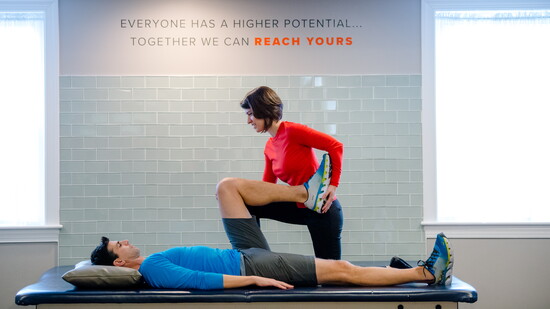As the glory days of our college sports careers pass, we are challenged to find replacement activities that keep our bodies in shape and fill a competitive outlet. Whether participating in a daily jog or weekly men’s pick up league, the combination of age and changing fitness levels can make staying injury-free difficult.
Being a physical therapist for over 20 years, there’s a fair share of injuries that result from weekend sporting events.
Here are the top five injuries most seen in the weekend warrior and how best to manage those ailments.
- Plantar Fasciitis
Plantar Fasciitis is an inflammation of the arch of the foot that occurs most frequently when someone increases physical activity rapidly without proper stretching or footwear.
- Symptoms: a burning/tearing sensation in the arch of the foot during weight bearing, most prevalent in the morning, which worsens with activity.
- Treatment: Plantar fasciitis can be very painful and treatment options are numerous. Stretching the calf muscle in a runner’s stretch will help loosen the posterior aspect of the leg. In addition, massaging the bottom of the foot with a tennis ball before weight bearing in the morning will improve the flexibility of the arch. Lastly, adding insoles to your shoes will provide additional support to the arch of the foot to relieve pain.
2. Shoulder tendonitis
Usually shoulder tendonitis occurs gradually after performing extended overhead tasks like throwing, lifting, or swinging a racket. Sometimes, however, a sharp popping sensation may occur during a specific movement.
- Symptoms: Sharp, pinching pain usually associated with movements including reaching overhead or behind the back
- Treatment: Resting your shoulder will be paramount in letting the inflammation settle. In addition, you can use ice or an over-the-counter pain medication. The most effective treatment is improving your movement to allow for more normal shoulder function. You can achieve this thorough stretching, proper strength training, and movement education under the guidance of a professional.
3. Pulled back muscle
Since the majority of Americans spend the lion share of their day sitting, back strain is a common ailment. Low back pain remains one of the most common injuries at urgent care facilities.
- Symptoms: Often a gripping pain in the low or mid-back that limits the ability to move, breathe, or bear down.
- Treatment: Gentle movement is key when faced with a low back strain. Allowing the your body to gently twist will remove inflammation from the area, prevent worsening of tightness, and restore normal movement. Heating pads and over-the-counter medications can keep the pain at bay to allow the ability to return to normal activities sooner.
4. Achilles tendonitis
Much like plantar fasciitis, Achilles tendonitis occurs when someone increases their activity level quickly or changes to a dynamic form of exercise.
- Symptoms: aching/burning/tightness in the calf or where the calf muscle attaches to the heel.
- Treatment: Stretching the calf muscle will help alleviate pain and improve the muscle’s ability to tolerate load. In addition, performing gentle heel raises will increase the muscle’s tolerance to activity. Massaging the muscle with a foam roller or massage gun is also helpful to reduce pain and increase flexibility.
5. Knee pain
Since the knees take most of the force in our body, it is typical for them to be sore with activity. Determining the type of knee pain is critical to understanding treatment.
- Symptoms: Achiness in the joint, sharpness at the joint line, burning on the outside of the knee, catching or locking
- Treatment: Symptoms in the knee are variable and therefore must be assessed by a trained professional. The symptom and onset often determine the treatment for conditions ranging from arthritis to meniscal tears or IT band tendonitis. Modification to your activity might be necessary depending on the injury. Sometimes a light, neoprene support sleeve can provide the weekend warrior and how best to manage pain.
Pain with activity is common, especially when participating in sports isn’t a regular practice. If you experience pain that lasts more than 24 hours or keeps you from performing your normal daily tasks, see help from a doctor or physical therapist to determine next steps. Treatment is often easy to implement and readily available to help get you back to your competitive endeavor as soon as possible.
reachyours.com
Watching and participating in the game, staying involved, keeping it safe and working it out maintains the spirit.
